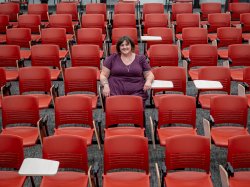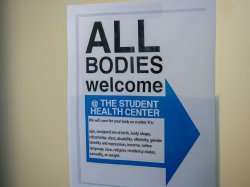Fighting Fat Discrimination in Higher Education
How a Montclair State University student’s research is driving change on campus
Posted in: Arts, College for Education and Engaged Learning, Education, Research, University

When Montclair State University student and staff member Stephanie Spitz encountered classroom furniture that couldn’t accommodate a larger student’s body, it sparked a graduate research project addressing weight-based discrimination. Now, her work is driving meaningful change in higher education.
“Anti-fat bias has surpassed discrimination based on race and gender and sexuality, so it’s the most prevalent form of discrimination out there,” Spitz says. Yet, “there are no legal protections for fat people.”
“Anti-fat bias is so present but there’s never been a space for that discussion,” says Office for Social Justice and Diversity Director Adela Caceres. “This is a huge learning opportunity.”
As a Montclair alumna, MFA Studio Art ’16, currently pursuing a master of arts in Higher Education, Spitz also serves as Department Administrator for Art and Design. Identifying as a “fat person” – a term she uses descriptively and as an identity – she is committed to raising awareness about this often-overlooked bias and improving inclusivity on campus.
Turning Research into Action
Spitz’s efforts have already influenced leaders and staff at Montclair State University, resulting in positive changes on campus including:
- Inclusive Classroom Design: A renovated lecture classroom in Calcia Hall now features seating for larger students and those with disabilities.
- Health-care Accessibility: The Student Health Center updated its policies and spaces to better serve all students. Changes include offering gowns in various sizes, implementing a “Decline to Weigh” policy, and prominently displaying inclusive signage.
- Community Awareness: Spitz helped organize Montclair’s first flag-raising ceremony for Disability Awareness Month in conjunction with LGBTQ+ History Month and with the Office for Social Justice and Diversity, the Disability Caucus and the Disability Resource Center.
The “Decline to Weigh” policy allows patients to opt out of being weighed when seeking services. If deemed medically necessary to obtain a weight, those measurements are taken “blind,” says Interim Student Health Center Director Sarah Jennings, “meaning the numbers are not shared with the patient.”
Spitz says such a policy “is particularly important for students with eating disorders as seeing or knowing their weight can trigger dangerous eating disorder habits. If we can dispel the myth that your weight is controllable and the way that your weight impacts your health – it’s a very small portion – those are the two key things that I’ve been trying to dispel, because that’s what the research says helps with biases.”Jennings praises Spitz’s commitment, noting that her involvement “prompted a number of meaningful changes.”

Raising Awareness Across Campus
Taking advantage of President Jonathan Koppell’s invitation to students to walk and talk with him around campus, Spitz shared some of her findings with him. In turn, he shared it with members of his leadership team, who have been receptive to her presentation on the history and implications of “Weight Based Discrimination.”
Vice President for Student Development and Campus Life Dawn Meza Soufleris, who has Spitz in a graduate class, invited Spitz to present her research to her staff. “She has been advocating for a number of things via the Disabilities Caucus, including larger seating and other body-positive frameworks, as well as teaching many of us the history of anti-fatness from a DEI perspective. It’s fascinating and is her passion.”
She may have a larger campus audience in the spring. Associate Vice President for Inclusive Excellence and Special Assistant to the President Ashante Connor says: “We are working to provide a platform for her to raise awareness and educate our community around weight inclusion. Anti-fatness shows up in ways that typically our conscious mind is unaware of, especially in the hiring process and other selection processes. Our goal is to provide a space and platform for any employee who is committed to advancing inclusion and access for the entire community.”
Spitz also has shared her findings with the Disability Caucus, of which she is an executive board member, as well as the Office for Social Justice and Diversity professors and students.
Office for Social Justice and Diversity Director Adela Caceres, who also serves as Spitz’s mentor, found the information eye-opening and invited her to a training for about 30 graduate and undergraduate students who work with the office. “She’s doing some amazing work,” Caceres says. “Anti-fat bias is so present but it’s never talked about, and at a university like this, where we have such a diverse group of students, there are many that identify with this particular community, but there’s never been a space for that discussion. Even for me, it was a huge learning opportunity.”

Key Takeaways from Anti-Fat Bias Research
Spitz’s research highlights that anti-fatness is a complex, multifaceted issue with deep historical roots and wide-ranging impacts on individuals and society. Major takeaways from the findings include:
- Historical roots: Fat people have existed across the world for as long as thin people, dating back to the Paleolithic era’s Venus of Willendorf. “Small-fat” bodies were considered the ideal beauty for white women during the Renaissance. This changed during slavery, however, when America and European colonialists started portraying black bodies negatively to further legitimize the oppression of black people for over 500 years.
- Legal discrimination: “It’s actually legal to discriminate against fat folks in 48 states,” Spitz says. “New York City just passed a law in 2023 forbidding it, but it’s still legal within the state of New York.” While it’s still legal in New Jersey, a bill making it illegal to discriminate against people because of height and weight has been advanced by the Senate Labor Committee; a House bill has not been introduced.
- Gender bias: Women experience more systemic discrimination and interpersonal bias related to body size than men. There’s also more focus on women’s bodies and appearance in professional settings. “A lot of my research shows massive disparities in employment income, especially for women,” Spitz says.
- Religious influence: The rise and spread of Protestantism linked eating habits and body weight with morality, leading to a persistent mentality that people are “good” or only deserve health care if they’re trying to be healthy.
- Anti-fat fashion: Clothing and fashion has also played a key role in stigmatizing fat people and the industry still largely promotes thinness, especially for women.
- Everyday challenges: Fat people face numerous everyday challenges, from fitting into cars to dealing with furniture designed for smaller bodies.

Why Weight Bias Matters in Higher Education
- Physical Infrastructure: Campus spaces often fail to accommodate larger bodies, from classroom chairs to dorm showers.
- Social Bias: Fat students face bullying and exclusion, compounded by misconceptions about weight and health.
- Mental Health: Stress from discrimination and feeling singled out can harm students’ well-being and self-esteem.
- Health-care Disparities: Reliance on outdated measures like BMI perpetuates biased care. Spitz emphasizes that some patients with higher BMIs can have normal lab results and blood pressure.
- Limited Representation: A lack of diverse body types among faculty and in campus media may reinforce feelings of exclusion.
Recommendations for Change
Spitz has a long list of recommendations that could result in cultural and systemic changes at Montclair and other institutions of higher education to combat anti-fatness, including:
- Expanding mental health resources for students with eating disorders and weight-related stress.
- Incorporating sizeism into diversity training for hiring committees.
- Representing fat individuals positively in campus advertising and media.
- Increasing clothing and mannequin sizes at university bookstores.
What’s Next for Anti-Fat Bias Research and Advocacy?
While systemic changes take time, Spitz is determined to keep advocating for inclusion. She is also working on publishing a peer-reviewed study focusing on weight-based discrimination in higher education. “Seeing these results will be healing for so many students for years to come,” she says. “I’m so grateful for all my mentors and collaborators on-campus who supported me and gave me the opportunities to present my work.”
I’m a ______, tell me more…
Prospective Student / Parent: Learn more about Art & Design and Higher Education or plan a visit to our campus and take the first step in applying to become a Red Hawk!
Journalist: Contact the Media Relations team for assets or to schedule an interview with the researcher about this topic. See more Faculty Experts and hi-res media assets available for download.
